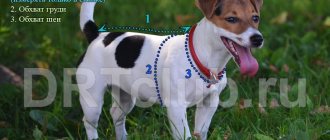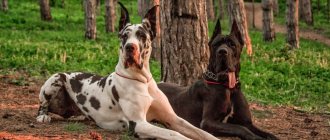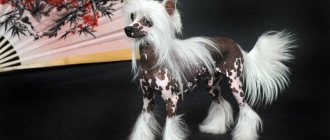Dog hair and its purpose
Wool is of great importance for a pet because it provides protection from environmental factors. It protects the dog from parasites, infectious diseases and bad weather.
It is worth noting that wool is an indicator of the dog’s health. Soft, silky and shiny fur means that the pet feels good and gives no reason for concern. However, a dull and lifeless coat of an animal may indicate health problems.
Why Wool May Look Bad
As a rule, a dog sheds constantly for various reasons. But this shedding is preceded by a change in the condition of the coat. So, initially the dog’s fur may become dull and hard, and only then the hairs will begin to fall out.
This can happen for a number of reasons:
- Poor, unbalanced or irregular diet.
- Diseases of the gastrointestinal tract.
- Kidney diseases.
- Decreased immunity.
- The appearance of parasites in the animal's body.
Hair loss is a consequence of the appearance of such factors. When the disease has already been cured, many owners observe that the dog still sheds heavily. What to do in this case? Nothing, wait a certain time. Due to the stress experienced, shedding may continue for several months after treatment.
How different dog breeds lose hair
This process does not occur in the same way for all pets - much depends on the predisposition of the breed and the type of fur of the animal.
A dog's coat consists of an outer and an inner layer, which performs insulating functions. Depending on the length of the coat and the density of the undercoat, natural shedding varies.
Due to the lack of dense undercoat, the long-haired Yorkie loses a little hair during this period. Likewise the short-haired dachshund, pug or basset hound.
In turn, a German shepherd, even with a short haircut, has a thick layer of insulation, the loss of which twice a year can really disturb the owners of the apartment.
The dog sheds heavily: what to do?
If your pet begins to shed heavily, and at the same time you notice changes in its behavior, then you have a reason to take the animal to the veterinarian. It is especially important to start treatment on time if the hair falls out asymmetrically. This may indicate the presence of serious diseases.
If the pet’s coat was fine for a long time, but the dog suddenly began to shed, then the following factors could be the cause:
- Experienced stress.
- Separation of dogs from owners.
- Rehabilitation period.
- Allergy to shampoo or medicine.
- Dog bedding made of synthetic materials.
- Using household chemicals in the home that cause irritation.
To be sure to find out the cause of hair loss, contact your veterinarian.
If you are concerned that your dog sheds a lot, what to do and how to deal with it, then try checking your pet for parasites.
Small pests as a cause of molting
Parasites are one of the most dangerous causes of shedding in animals. Their timely identification protects the animal from numerous problems. The scabies mite is the worst of parasites. It provokes rapid infection of the animal. Scabies is painful for a dog. In addition, this is a contagious disease, so all family members, including children, can contract the pathology.
Special tests help determine the presence of the parasite in the animal’s body and remove it in a timely manner. In addition to the scabies mite, there are several other types of pathogens. Among them are ringworm, seborrhea, color mutation alopecia, and yeast infection.
Worms also cause your dog to shed heavily. What to do in this case? Fight helminths with the help of medications. In the early stages of development, these parasites pose minimal danger, but over time the worms can cause painful symptoms in the animal, such as weakness, vomiting, tension, and itching.
Hair loss as an alarming symptom
Some owners pay attention to an unusual smell for dogs, which confirms the abnormal functioning of the skin glands. Why did it happen so? There can be many reasons for this unpleasant phenomenon - from low-quality shampoo to food scraps eaten on the street.
The coat sheds a lot due to stress. Fights, injuries, visits to the veterinarian and other shocks can trigger hair loss, however, this process should not last all year round. Perhaps the unrest triggered some disease that was in a chronic form.
Many owners are interested in why shedding occurs after giving their pet a treat. Why did it happen so? The fact is that even a healthy dog can suffer from an allergy that manifests itself after eating a certain product, and you should not experiment with treats.
If after such an episode the fur sheds, and the pet has lost weight and turns away from its usual food, then the owners should be wary and take the dog to a specialist. In addition, the allergic reaction may be accompanied by itching, agitation and drooling.
Unexpected shedding often indicates a dangerous illness - a non-food allergy. The reaction of the animal’s body in this case is caused by inhalation of polluted air, products of flowering plants, or lying on synthetic bedding.
Every pet owner should know how many times a year to treat their dog with anti-parasite products and what to do if the dog is directly infected. Flea and tick bites provoke scratching, which leads to hair loss, and if the pet has lost weight and cannot grow a thick coat for a long time, it is worth checking your four-legged friend for the presence of worms. Timely treatment minimizes unpleasant consequences and helps get rid of symptoms.
Your dog sheds a lot in summer: what to do?
The molting of an animal in the summer causes concern to owners, since this period is not intended for changing the animal's fur coat. If your pet begins to lose six during the warm period, pay attention to:
- The air temperature in the room where the dog lives. If it is above 26 degrees, then the dog’s shedding is not surprising.
- Pet food. In the warm season, the dog should receive a balanced diet to provide the body with vitamins.
- Air circulation in the house. If it is missing, the dog may contract skin diseases.
Don't forget about the possible presence of parasites in your pet's body. In summer, the animal walks more often, and microorganisms are more resistant to the environment, which increases the chances of infection.
Any of these factors can cause your dog to shed heavily during the summer. What to do:
- Maintain normal air temperature.
- Ventilate the house regularly.
- Diversify your dog's menu.
- Choose vitamins for your pet.
- Don't forget to give anthelmintics.
If the animal continues to shed, you should consult a doctor.
How to prevent and stop hair loss
If tests show that the hair loss is not due to pathogens, and everything is in order with the pet’s health, then you must provide the dog with proper care.
Firstly, do not use shampoos intended for humans to bathe your dog; this is unacceptable. The skin structure of humans and dogs is different, so your hygiene products can provoke an allergic reaction and shedding of your pet.
Secondly, do not bathe your dog more than once a month. At the same time, choose a barely warm water temperature. Hot water will not only cause discomfort to your pet, but will also cause a stress reaction in the body.
Remember that shedding twice a year is normal for a dog. Don’t panic too much, because sometimes it’s enough just to help your pet survive the period of hair loss.
Treat the animal's fur coat with special drops that will prevent the appearance of parasites in the body. This medicine can be purchased at a veterinary pharmacy.
If your veterinarian has made a diagnosis that explains the hair loss, your pet will be prescribed treatment. It must be observed strictly, and then ensure that the causes of molting do not reappear.
Factors influencing the shedding process in dogs
It is important to know that coat change occurs 2 times a year and is regulated by temperature parameters. So, the dog sheds with the arrival of cold weather in the fall, as well as in the summer, which is the norm. Experts note the presence of age-related changes, as a result of which the color of the animal becomes different; this occurs mainly in young individuals.
Slow molting, which lasts all year round, should alert the owner. Veterinarians identify the following reasons why your four-legged friend constantly loses hair:
- lack of vitamins;
- diseases of internal organs;
- hormonal imbalance;
- decreased immunity.
In addition, some pet breeds have a very thick undercoat, and the new owner does not know how many times a year the dog sheds. A person can help a dog get rid of excess fluff and make its coat lighter by brushing the animal daily with a special brush. So, a gentle massage of the skin is performed and excess hair is removed.
We recommend reading: The First Signs That Your Dog Will Be In Labor Soon
But why do pets that don’t have a luxurious coat take a long time to shed? The fact is that the dog’s diet should include vitamins and components that add shine and improve the quality of the coat. In addition to natural food, the dog is given fish oil, liver, and supplements as recommended by a specialist.
The animal also sheds heavily all year round due to internal diseases or parasites, which leads to a decrease in immunity and a deterioration in the pet’s well-being. In this case, alarming symptoms should prompt a visit to the veterinarian, he will conduct an examination and prescribe treatment.
Domestic dogs that live in an apartment permanently are susceptible to hormonal imbalance. Proper nutrition and regular exercise will help eliminate disorders.
How to help your pet survive shedding
If your pet has begun to shed seasonally, you can’t just watch the process of changing coat. The animal needs quality care. Don't be alarmed if your dog sheds a lot. Any veterinarian will tell you what to do during this period, but the care measures are very simple.
First, brush your pet's fur regularly to ensure timely change of hair follicles.
Secondly, analyze and eliminate deficiencies in the dog’s diet so that the hair does not fall out too much.
Thirdly, do not bathe your pet more often than usual. However, you can purchase a special shampoo that will prevent healthy hair loss.
Don't you like that your dog sheds a lot? What to do? Get yourself a pet that is not subject to seasonal coat changes.
Why is the shedding mechanism needed in dogs?
Shedding in dogs under normal conditions occurs twice a year. This is the period of transition from autumn to winter and winter to spring. At this time, the coat is renewed naturally. It is worth noting that the process of changing coat is closely related to the general condition of the pet’s body, its well-being and immune system.
A coat that is shiny and thick is an indicator of good health. But with changes in the body, the coat becomes dull. The basic functions of the coat in domestic dogs are:
- protecting your pet’s skin from ectoparasites (fleas and ticks);
- protection against the penetration of various pathogenic microorganisms that can provoke an inflammatory process on the skin;
- protection from all kinds of aggressive environmental factors - cold, rain and wind.
The molting period in the autumn is characterized by the replacement of the summer coat with a new one. At this time, the undercoat begins to emerge, thick and warm, allowing the dog not to freeze even in the coldest winter.
Autumn shedding in dogs takes longer than spring, although there are significantly fewer tufts of fur. Visually, the dog increases in volume, but at the same time becomes more tender and soft to the touch.
After the end of the frost period, dogs begin to shed in spring. It is shorter in time, but there are significantly more tufts of wool. This is due to the fact that the body begins to get rid of thick undercoat, preparing for the warm season.
The first shedding begins in dogs when they reach 6 months. But it is important to take into account not only the time of birth of the puppy, but also seasonal conditions, as well as the general condition of the pet.
It happens that the process of changing coat occurs unusually quickly in dogs with good immunity, taking from 5 to 7 days, less often it lasts 2 weeks. But this is only if the animal owner treats the condition of the pet’s fur with due attention.
Regular combing or grooming services can significantly reduce the number of clumps of fur scattered throughout the house. If your dog sheds a lot, the cause may be an internal disease.
A protracted process of coat change, especially not associated with seasonal changes, requires a mandatory examination by a veterinarian.
What breeds don't shed
Unfortunately, there are no breeds that do not shed at all. Some dogs shed significantly less hair than others, but they still shed some hair. These breeds include the following:
- Irish Water Spaniel.
- Soft coated wheaten terrier.
- Yorkshire Terrier.
- Poodle.
- Boston Terrier.
- Welsh Terrier.
Almost all terriers and lap dogs shed little, but if you want a pet whose hair does not fall out at all, then special hairless dogs have been bred that have no hair at all, so they cannot shed even during the season.











